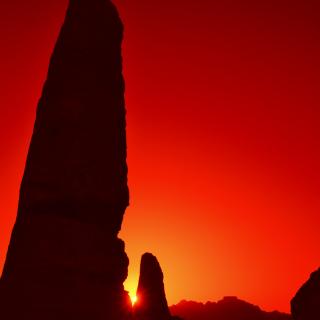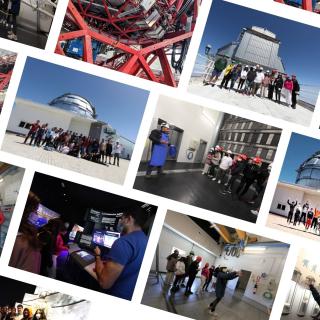José Lull knows a lot about the royal Egyptian tombs of the Third Intermediate Period and the Late Period. In fact this was the theme of the doctoral thesis –published as a monograph by Oxford University Press- of this Egyptologist, with degree at the University of Tübingen (Germany) and a doctorate from the University of Valencia. He is presently at the Autonomous University of Barcelona, and is also an expert in the astronomy of ancient Egypt. He showed this recently at the Instituto de Astrofísica de Canarias, where he has been collaborating with Juan Antonio Belmonte, archeoastronomer at the IAC, and where he gave a lecture titled “Revealing the astronomers of ancient Egypt”. Because astronomy was one of the most powerful tools that the ancient Egyptians used in their continuous search for Ma’at, cosmic order on the Earth.
1. Was there a profession of astronomer in ancient Egypt? Was it a unique profession?
In ancient Egypt it doesn’t seem that there was a specific profession equivalent to that which we know as an astronomer. In Egypt, those who were dedicated to the observation of the sky would be priests who had many other jobs, which had nothing to do with the celestial world. But on the other hand, an astronomer who did not belong to the priesthood was also a scribe with the many other commitments of that profession.
2. How do we know this? What evidence has been preserved about it?
We know this thanks to the inscriptions which have reached us. We have numerous examples of people who, while using titles that recognize their function as astronomers and chronologers (using the stars to give the time, among other uses), also show that they have other very varied jobs, belonging to the civil service and to the world of religion. As an example we can take a noble called Tjenti, from the VI dynasty (around 2300 B.C.). He was “superior and observer of the secrets of the sky”, and therefore, an astronomer. But he was also “sem priest”, "reader priest”, “scribe of the divine book”, “great among the fortune tellers” in Heliopolis, among other functions.
3. What was the relation between astronomy and astrology?
Throughout the history of Egypt of the Pharaohs we can see that there was a relation between astronomy and the religious world, but not with astrology. Astrology as such was Mesopotamian in origin, it was introduced strongly in Egypt in the Ptolemaic epoch. Nevertheless, before this happened, we do have evidence that the Egyptians, just as other ancient cultures, associated celestial events with good or bad omens. This was clearly expressed, for example, in a well know stele of King Mrenptah, son of Ramses II, in which it says: “He is the one who brings the downfall of his enemies, so say those who scan the stars”. Another, later text, the Chronicle of Prince Osorkón, says: “Although the sky did not swallow the Moon (although there wasn’t an eclipse of the Moon), a major struggle occured in this country”, that is, an eclipse was understood to be a bad omen.
4. We know that many Egyptian buildings had astronomical orientations. Where did the “astronomers” observe from?
The Egyptian astronomers observed from the terraces of the temples and palaces. From that height they looked for horizons free from obstacles. So, for example, in the papyri of Abusir, of the V dynasty, it mentions “viewers on the terrace of the temple” and in all probability these viewers were astronomers and observers of stellar time. In a stele of the New Empire a personality had the title of “timekeeper/astronomer on the roof of the palace”.
5. What instruments did they have for observation and measurement?
The observational instruments used by Egyptian astronomers were very simple. They had the “bay” a palm frond on whose upper part they had made a Groove to use as a viewing instrument. Then, the merkhet was basically a piece of wood which was placed horizontally and from which a plumb-line was hung. It could be used in combination with the bay. We can also infer the existence of another two instruments for observing: a type of gnomon, which appears drawn on many astronomical roofs; and a type of grommet, which could well correspond to the strange object crowning the head of the godess Seshat. Of course, the Egyptian astronomers also used clepsydras, as well as clocks using the Sun and shadow. And for their observations they had lists of stars with information about risings, settings, and culminations.
6. Did they have a special form of dress?
A statue of a noble who was an astronomer in the XVIII dynasty, called Aanen, currently in the Egyptian Museum of Turin, shows him dressed, like a priest, in a panther skin. However, instead of spots it is decorated with stars. Also the goddess Seshat, linked in part to the heavenly world, often displays clothing decorated with stars. Taking this into account we could say that, if there was a special form of dress for Egyptian astronomers, it could be like that of Aanen. But as this is an exceptional example, and the rest of the astronomers we have been able to identify do not show any kind of distinctive clothing, it is most probable that an Egyptian astronomer would not normally dress in any kind of uniform which would identify him.
7. What were the discoveries by astronomers in ancient Egypt? Could they predict eclipses? Did they see any comets?
The great discovery which the ancient Egyptians bequeathed us is the year of 365 days, and the division of the day into 24 hours (even though the latter is not really a question of astronomy). They catalogued stars, observed stars in the deep sky visible with the nake eye, followed precisely the motions of the Sun and the Moon, but did not know how to predict eclipses and although they must have seen hundreds of comets, they have not left us even a single reference about this. We must bear in mind that none of the books or treatises on astronomy written by the Egyptians have come down to us, even though we know many of their names.
8. Did they divide the sky into constellations. Were they similar to, or different from ours?
As in usual in most cultures, to impose order and recognize better the stars covering the celestial sphere, the Egyptians did form constellations out of groups of stars. Behind these constellations lie stories and mythologies, but in the immense majority of cases we do not know them. Some, however, are well documented, such as the constellation of Meskhetiu (made up of the seven principal stars of the Great Bear), which according to the Egyptians corresponds of the foot of the god Seth, which he lost in one of his fights with Horus (represented by the constellation of Anu) and which was taken up to the circumpolar sky, and tied there with a chain of gold to two binding posts supported by the godess Isis in the form of a hippopotamus (another of the Egyptian constellations). The constellation of Mai, the lion, corresponds to our zodiacal Leo, but in the Egyptian case we don’t know its mythological significance. We can see that there is a certain similarity between the concept of a constellation in ancient Egypt and ours, with very variable sizes, and with associated stories which would have made them more recognizable to the Egyptians.
9. Did they have a godess of Astronomy?
The Egyptians did not have a godess or a muse of Astronomy in the style of Urania in the Greek world. However, the godess Nut was the godess of the sky par excellence, maybe represented in the sky by the Milky Way.
10. What collaboration do you have with the IAC? To what extent are the perspectives of a historian and an astronomer complementary?
With the IAC, and in particular with Dr. Juan Antonio Belmonte, I have a good relation and a friendshhip which goes back many years now. We have worked together mainly on the identification of the sky of the Egyptians, obtaining excellent results. And we are now working on a monograph, Ancient Egyptian Astronomy, which will be published in 2021. We make a good team, because his professional training as an astronomer, with a passion for ancient Egypt is perfectly complementary with mine as an Egyptologist with a passion for astronomy. In my opinion, this combination is an ideal formula for tackling many of the problems posed by ancient Egyptian astronomy.
Video interview on our Youtube channel:






